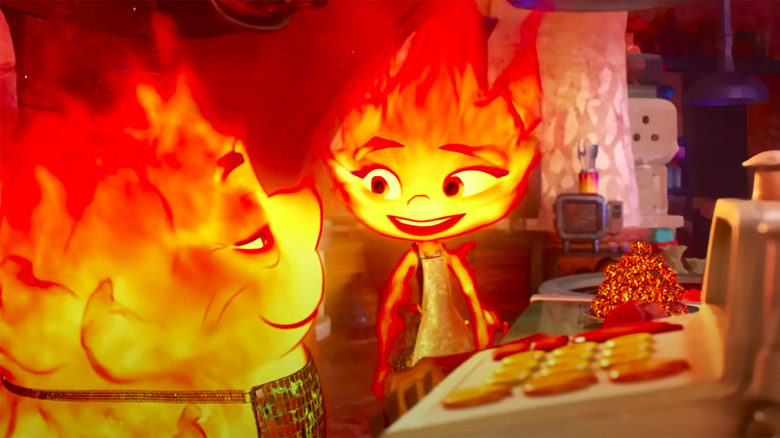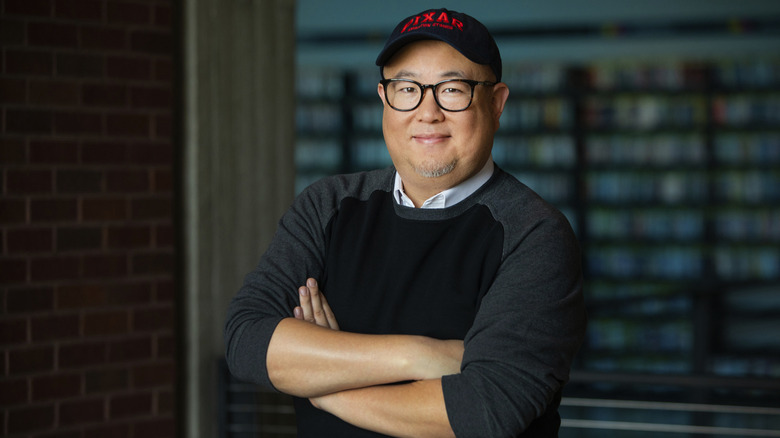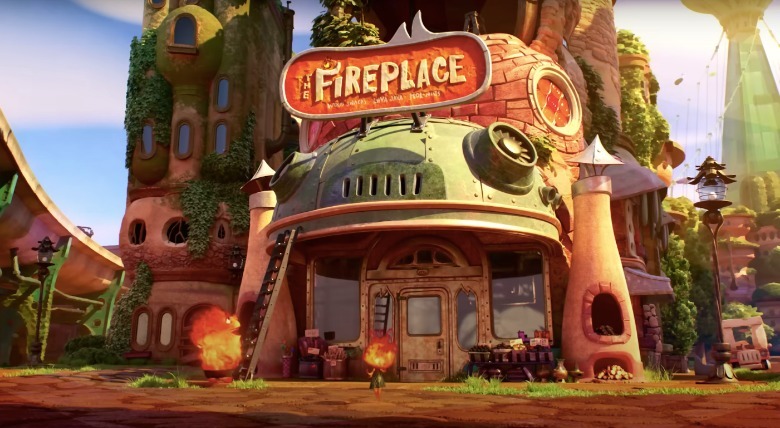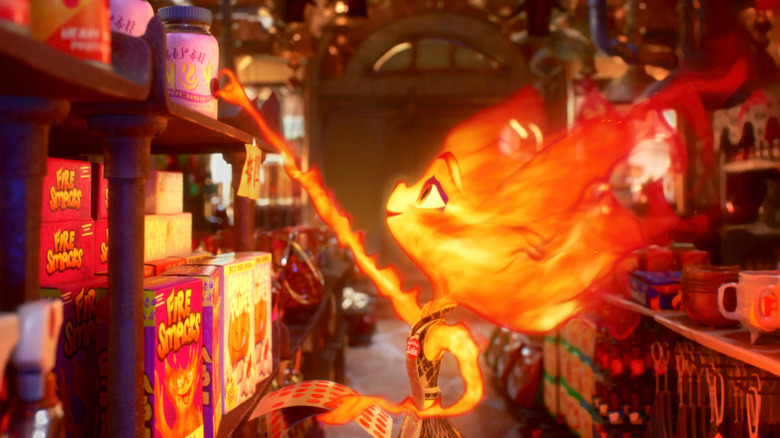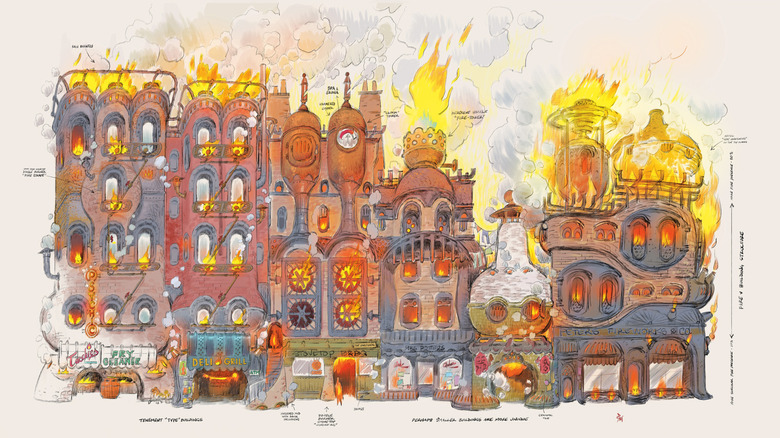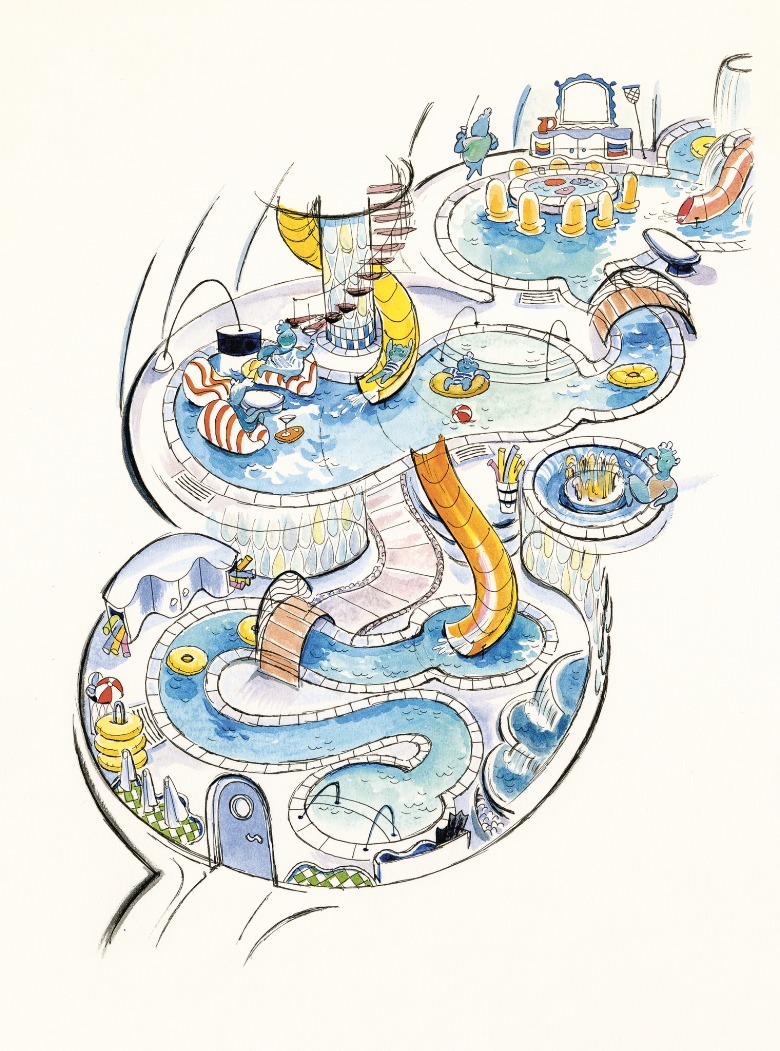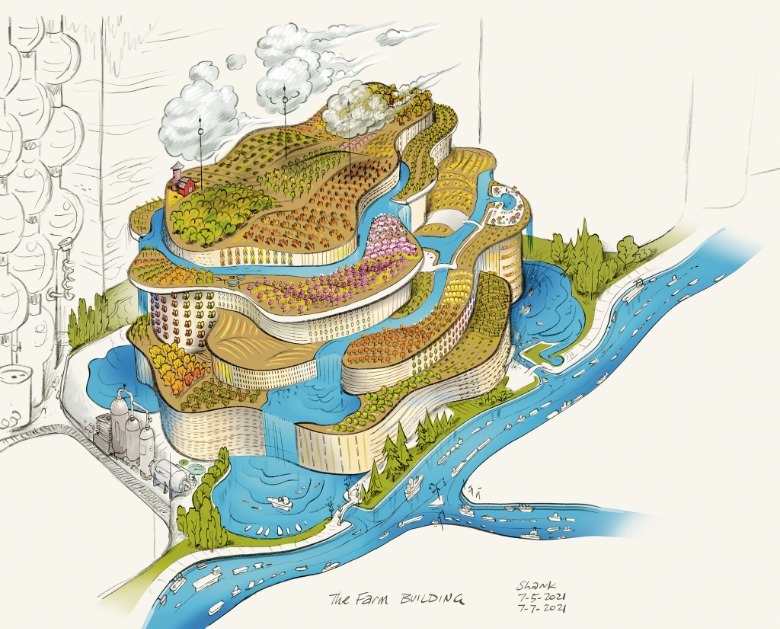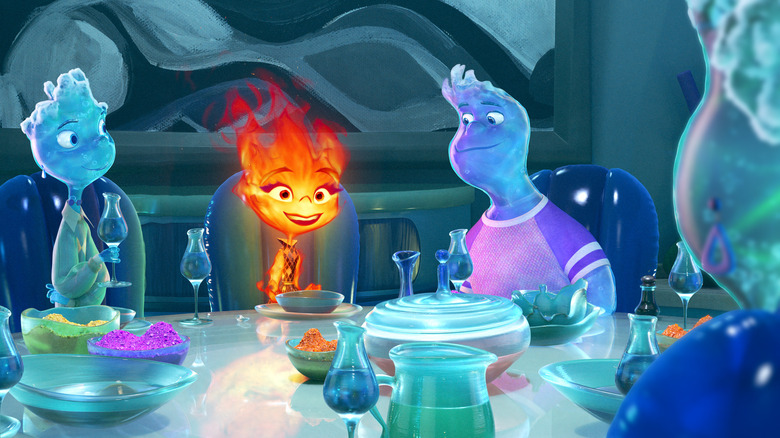Pixar's Elemental Isn't Just A Romantic Comedy, It's Also A Very Personal Immigrant Tale
Earlier this week, Pixar dropped a new trailer for "Elemental," which will mark the animation studio's return to the big screen with an original movie since "Onward" hit theaters just before the coronavirus pandemic ruined everything. Since 2020, Pixar's movies "Soul," "Luca," and "Turning Red" have all been relegated to Disney+, though the latter was intended for theaters, it ended up being pushed to streaming because of a coronavirus variant outbreak. Frankly, we're ready for Pixar to bring their brand of storytelling magic to the big screen with a movie like "Elemental," especially after "Lightyear" turned out to be a bit of a disappointment.
Before the new "Elemental" trailer arrived online, Disney and Pixar invited /Film and an assembly of other media outlets to the Pixar Animation Studios headquarters in Emeryville, California for an extended sneak peek of footage from the upcoming film. After screening around roughly 30 minutes of the promising movie (read our footage reaction here), as well as checking out the new "Up" short film with Ed Asner returning as Carl with the talking dog Dug by his side, director Peter Sohn, producer Denise Ream, and key members of the film's team at Pixar delivered a presentation that provided a deep dive into the development of the movie.
Not only did we learn about the technically challenging process of making the movie, but we found out that this project is quite the personal story for both Sohn and Ream. Though "Elemental" is clearly a romantic comedy between a woman made of fire named Ember and a man made of water named Wade, it's also the story of an immigrant family trying to create a life for themselves in a place that isn't necessarily welcoming to them on a fundamental (and literally elemental) level.
'...they all were mixing into beautiful little neighborhoods with their cultures and their languages'
Director Peter Sohn, who previously directed "The Good Dinosaur" after filmmaker Bob Peterson stepped down from the project following creative differences, is at the helm of "Elemental." Though his pitch to Disney came with the deceptively simple question of whether fire and water could ever actually connect, the inspiration for the story actually came from parts of Sohn's personal life.
First of all, Sohn's parents were Korean immigrants who came to the United States in the late 1960s/early 1970s. Much like Ember's family in "Elemental," Sohn's parents arrived with little money, didn't speak much English, and had to carve out a life for themselves to make America their new home. That included Sohn's father opening up his own grocery store, not unlike The Fireplace that Ember's family runs in the middle of the borough known as Firetown.
In "Elemental," after Ember's parents renovate a rundown building, a bustling community of other fire people rise up around them. As Sohn recalled, "All my dad's customers came from everywhere, and like my parents, they left their homes to come to a new land, and they all were mixing into beautiful little neighborhoods with their cultures and their languages."
It's not unlike the environment that Pixar has cultivated, and many of the key crew members who worked on "Elemental" have parents who came from around the world to build a new life for themselves in the United States. Producer Denise Ream showed pictures of various Pixar employees as children with their parents, and she also shared her own family story, which not only involves her ancestors coming to Boston by way of Ireland, but also her husband immigrating to the United States and becoming an American citizen.
'My biggest goal was to try to take the element itself and pull from there to make the culture'
However, in "Elemental," Ember and her family aren't explicitly made to represent a Korean family or any one specific race. Instead, the fire people share various traits of a variety of ethnic backgrounds. The store sells a shirt that says "Kiss Me, I'm Firish," alluding to Irish culture. Because they're fire people, of course there's a love for spicy food, which can be attributed to a variety of cultures around the globe. Sohn confirmed this was an intentional approach to avoid direct comparisons to a single background:
"Once people started saying, or asking, 'Oh, are they Asian?' It's like, 'No, no. They're not meant to be Asian.' Or is, 'Air meant to be this culture?' Quickly I would realize, 'No, no, no, these have to be universal.' My biggest goal was to try to take the element itself and pull from there to make the culture. Obviously, if you go too far, it could become alien, so you do have little grounding ways to do that. Something that was really interesting was disruption. Meaning, you think there is a piece of a culture that is mixed with the fire element on top, but then the next one should take you into another place where it's giving you other values of cultures that we know, but without it pointing to anything. But more than anything, it was just saying like, 'Oh, they're fire people. They eat wood. No Earth people eat wood in this way. How can we exploit that? What kind of plates would they have?' So it'd be extrapolating everything we could from the culture."
Another example comes from the fire language Ember's family speaks in, which was specifically crafted for "Elemental" and sounds like it has a slavic origin but with a fiery spin. In fact, the language was created by David Peterson, who constructed languages for shows like "Game of Thrones" and movies like "Dune." Ream indicated that there was originally more of the "Firish" language in the movie, but they pulled it back.
There are other such elements inspired by the likes of Polish, Jewish, Middle Eastern, and Asian backgrounds that those with familiarity will easily recognize. But this all comes from something that Sohn imagined when he was a kid, and not unlike life as we know it, everything began with the periodic table of elements.
The periodic table of Elemental
As a child, when Sohn looked at the periodic table of elements, he imagined the rows and columns making up an apartment complex with all the elements living next to each other, where "platinum lives next to gold, but be careful of mercury because they have toxic relationships." Sohn thought of "stories of what these elements were doing in their apartments, mixing around in my head."
Though the periodic table of elements contains much more than water, air, earth, and fire, this approach to these scientific pieces resulted in creating Element City, and figuring out how these elemental people would interact and co-exist with each other. As production designer Don Shank explained, "Our ultimate goal though was to make sure that all the various elemental buildings felt like they belonged together along with the elemental characters all in one world."
Shank touched upon how they created Element City, especially the residences where the characters made of water, air, earth, and fire live. For Firetown, you'll notice that the buildings resemble brownstones from the real world, but they've been designed in such a way that they replicate cooking pots, stove burners, gas lamps, clay ovens, and fireplaces.
Meanwhile, the water residences, which are quite upscale, include city towers that resemble massive dams, with water cascading beautifully down the side, almost as if it's part of the structure itself. Another building features a Galileo thermometer turned into a high-rise apartment, where Shank envisioned that "each of the little bubbles inside was a floating apartment."
For earth buildings, you'll see a lot of greenery and floral accents, including a farm-style terraced downtown complex. But there are also luxury buildings to be found, such as one inspired by a flowering orobanche.
On the air side of Element City, you'll noticed buildings inspired by kites and structures that are very airy with fans, windmills, and weather vanes as aesthetic touches. One of the most prominently featured air structures includes Cyclone Stadium, a massive sports arena shaped like a tornado where games of Air-Ball are played by cloud people with massive crowds in attendance. Though there are plenty of water people inside as well, so much that they all form a literal wave around the stadium crowd.
Opposites attract
Of course, the story truly took shape because of Ember and Wade. The idea of opposites attracting, with fire and water falling in love, became their "North star." In fact, one particular piece of the complicated relationship comes from Sohn's own life, as one of his grandmother's dying wishes was for him to marry a Korean woman — and he didn't. But they also wanted "Elemental" to be more than that. As Sohn puts it:
"The initial concept was to try to make something universal, that we could have part of that connection with these two, fire and water. But then also understanding the family dynamic and that cultural part of it to make the film larger. Then there are other themes in this that I hope you guys also get out of it that make the film much bigger."
Though "Elemental" is very much being positioned as a romantic comedy, there are a lot more pieces to the puzzle, and it all begins with Ember's family trying to make a better life for themselves. This is as much a story about Ember and Wade's families as it is about their blossoming relationship. Sohn explained:
"I wanted to tell a story for everyone who's ever made a sacrifice, or taken a risk, and set it in the hustle and bustle of a crazy city. When I first started this, I had no idea how crazy this was going to really be, but the story of fire and water, how it would truly test the limits of our creative teams and our technical teams was something that went beyond my wildest dreams."
Not only was it a risk for Ember's family to leave their home and come to Element City, but Ember is taking a risk by going against her family's wishes — and maybe even nature. And both of these perspectives combine to form the backbone of "Elemental."
So what will happen with Ember and Wade? Can fire and water actually end up together? Will the world, and their families, let them be together, both literally and romantically? We'll find out when "Elemental" hits theaters on June 16, 2023.
